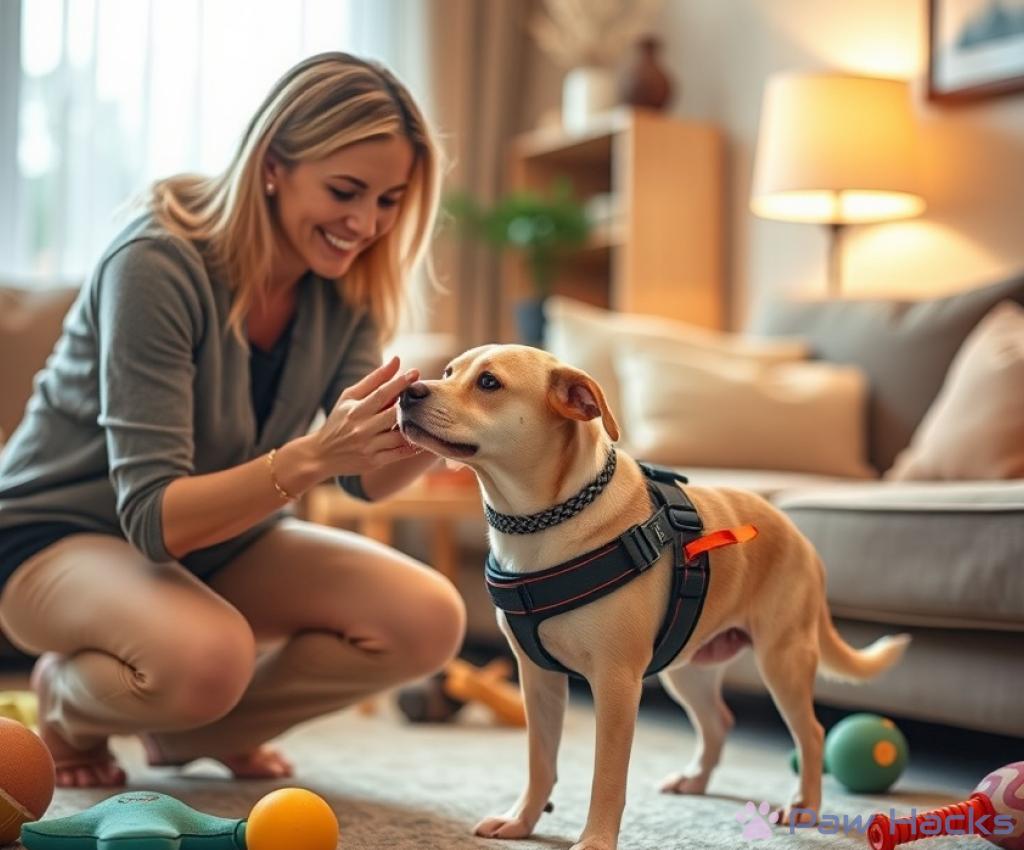Adopting Pets with Sensory Impairments
Understanding the Needs of Pets with Sensory Impairments

The Unique Challenges Faced by Sensory-Impaired Pets
Pets with sensory impairments, including blindness and deafness, often face unique challenges that can affect their daily lives. Understanding these challenges is essential for potential adopters who want to provide a loving and supportive environment. These pets may communicate and navigate the world differently, necessitating a tailored approach to their care and training.
Creating a Safe and Stimulating Environment
To ensure that pets with sensory impairments thrive, it’s crucial to create a safe and stimulating environment. This involves making modifications to your home and being mindful of the pet’s needs. For example, keep pathways clear of obstacles and use tactile cues to help guide them. Additionally, enriching their environment with scent-based toys and sound-emitting devices can enhance their experience.
Essential Care Tips for Sensory-Impaired Pets
Caring for a pet with sensory impairments requires patience, understanding, and a few specific strategies. Below is a list of essential care tips that can help these pets adapt and feel more comfortable in their new homes:
- Establish a Routine: Sensory-impaired pets benefit from consistency. A predictable schedule helps them feel secure.
- Use Positive Reinforcement: Reward-based training can help these pets learn commands and navigate their environment more easily.
- Incorporate Scent and Touch: Use scents and tactile cues to guide and engage your pet.
- Monitor Their Health: Regular vet check-ups are crucial, as sensory impairments can sometimes be linked to other health issues.
- Be Patient: Adjusting to a new home may take time, so offer your pet plenty of love and support.
Creating a Safe and Loving Home for Special Pets

Adopting a pet with sensory impairments can be a rewarding experience that adds depth to your life and theirs. However, it requires careful consideration and preparation to ensure that your home is both safe and nurturing. Understanding the specific needs of these pets is crucial to creating an environment where they can flourish. By taking the time to make thoughtful adjustments, you can help your sensory-impaired companion feel secure and loved.
Designing a Pet-Friendly Space
When designing a space for pets with sensory impairments, it is important to consider their unique ways of interacting with their environment. For instance, a blind pet may rely heavily on their sense of smell and touch to navigate. Therefore, creating a consistent layout in your home can greatly benefit them. Keeping furniture in the same place and using mats or rugs can provide tactile landmarks that help guide their movements. Additionally, incorporating scent markers around the house can create a familiar atmosphere, making your pet feel more at home.
Enhancing Interaction and Communication
Communication plays a vital role in the relationship between you and your sensory-impaired pet. For deaf animals, utilizing visual cues and body language becomes essential. Using hand signals or light flashes can effectively convey commands and intentions. For blind pets, your voice becomes a critical tool for reassurance. Regularly speaking to them, even when they can’t see you, can foster a sense of connection and comfort. Moreover, engaging in interactive games that rely on scent, such as hide-and-seek with treats, can provide both mental stimulation and strengthen your bond.
The Importance of Routine and Patience
Establishing a routine can significantly benefit pets with sensory impairments. A regular schedule for feeding, walks, and playtime helps create a sense of stability and predictability that can reduce anxiety. It’s equally important to practice patience as your new pet adjusts to their surroundings. Sensory-impaired pets may take longer to adapt to their new home, and they may require additional time to learn how to navigate their environment. Celebrate small victories and remember that your support is key to helping them thrive.
Training Tips for Caring for Pets with Hearing and Vision Loss
Empowering Communication Through Training
Training pets with hearing and vision loss can be a rewarding yet challenging experience. Understanding how to communicate effectively with these animals is vital for their integration into your home. For hearing-impaired pets, visual signals become the primary mode of communication. You can use hand gestures, lights, or even vibrations to convey commands. Meanwhile, for pets with vision loss, your voice takes center stage. Regularly speaking to them not only reassures them but also helps them associate your voice with safety and guidance.
Utilizing Positive Reinforcement for Enhanced Learning
Positive reinforcement is a powerful training method that works exceptionally well for pets with sensory impairments. Since these pets may have difficulty grasping verbal commands or visual cues, rewarding them with treats, affection, or playtime when they respond to your signals can significantly enhance their learning experience. For instance, when training a deaf dog, you might use a flashlight to signal a command and then reward them when they respond correctly. This method not only boosts their confidence but also strengthens the bond between you and your pet.
Creating a Consistent Training Environment
Consistency is key when it comes to training pets with sensory impairments. Establishing a dedicated training space that remains unchanged helps your pet understand what is expected of them. It’s beneficial to use the same cues and rewards each time you train. Moreover, integrating training into their daily routine aids in reinforcing learned behaviors. For example, if you consistently use a specific hand signal during feeding or playtime, your pet will begin to associate that signal with positive experiences. Remember, patience and persistence are essential; adapting to a new training regimen may take time, but the rewards of a well-trained pet are immeasurable.
The Joys and Challenges of Adopting a Sensory Impaired Pet
The Unconditional Love of Sensory-Impaired Pets
Bringing a pet with sensory impairments into your home can be one of the most rewarding experiences you will ever have. These unique companions often possess a profound ability to love and bond with their owners, creating a special connection that transcends their disabilities. The joy that comes from witnessing their resilience and adaptability can be incredibly fulfilling. Many families report that their sensory-impaired pets have taught them invaluable lessons in empathy and patience, enriching their lives in ways they never expected.
Navigating the Challenges Together
While the rewards of adopting a sensory-impaired pet are immense, it is essential to recognize the challenges that accompany this journey. These pets may require additional care and attention, which can sometimes be overwhelming for new pet owners. For instance, a blind pet may need help navigating their surroundings, while a deaf pet may require alternative methods of communication. Understanding these challenges is crucial to fostering a successful adoption experience. Adopters should be prepared to invest time and effort into training and creating a supportive environment tailored to their pet’s needs.
Building a Supportive Community
Adopting a sensory-impaired pet often comes with a unique set of needs, but you don’t have to navigate this journey alone. Building a supportive community can significantly enhance your experience. Connecting with other pet owners who share similar experiences can provide a wealth of knowledge and emotional support. Online forums, local meet-ups, and social media groups dedicated to pets with disabilities can serve as excellent resources. Additionally, reaching out to veterinarians who specialize in sensory impairments can further equip you with the tools necessary for successful pet care. Remember, the joys of adopting a sensory-impaired pet often outweigh the challenges when approached with love, understanding, and a strong support system.
Finding the Right Match: Choosing a Sensory Impaired Pet for Your Lifestyle
Adopting a pet with sensory impairments is a rewarding journey, but it also requires thoughtful consideration to find the right match for your lifestyle. Each sensory-impaired pet has unique needs and characteristics that can influence how well they fit into your home. Understanding these factors can help ensure a harmonious relationship that benefits both you and your new companion.
Assessing Your Lifestyle and Environment
Before you choose a sensory-impaired pet, it’s essential to evaluate your lifestyle and home environment. Factors such as your daily routine, activity level, and the layout of your living space can greatly impact your ability to provide the care and attention these pets require. Consider the following:
- Time Commitment: Sensory-impaired pets may need more time for training and socialization. Ensure you have the flexibility in your schedule to accommodate their needs.
- Living Space: A home with minimal hazards and clear pathways is ideal for a blind pet. For deaf pets, a quieter environment may be more comforting.
- Activity Level: Match the energy levels of the pet with your lifestyle. Some sensory-impaired pets may be very active, while others may prefer a more relaxed atmosphere.
Finding the Right Fit: Breed and Personality Considerations
When looking for a sensory-impaired pet, understanding the breed characteristics and individual personalities can guide your choice. Different breeds may have varying levels of adaptability to sensory impairments. For instance, some breeds are known for their calm demeanor, making them suitable for quieter homes, while others are naturally more energetic and playful.
It’s also important to assess the pet’s personality. Some pets may be more independent, while others thrive on companionship and support. Spending time with potential adoptees can help you gauge their temperament and see if they mesh well with your personality and lifestyle.
Helpful Checklist for Potential Adopters
As you navigate the process of finding the right sensory-impaired pet, consider using this checklist to ensure you’re making an informed decision:
- Research breeds and their specific needs
- Evaluate your living situation and daily routine
- Visit shelters and interact with sensory-impaired pets
- Consult with shelter staff about the pet’s history and behavior
- Prepare your home to accommodate the pet’s sensory challenges
- Commit to ongoing training and socialization efforts
By taking the time to carefully consider these factors, you can increase the likelihood of finding a sensory-impaired pet that harmonizes with your lifestyle. Remember, the journey of adoption is not just about providing a home; it’s about forming a lasting bond that enriches both your life and that of your new furry friend.
Share this content:



